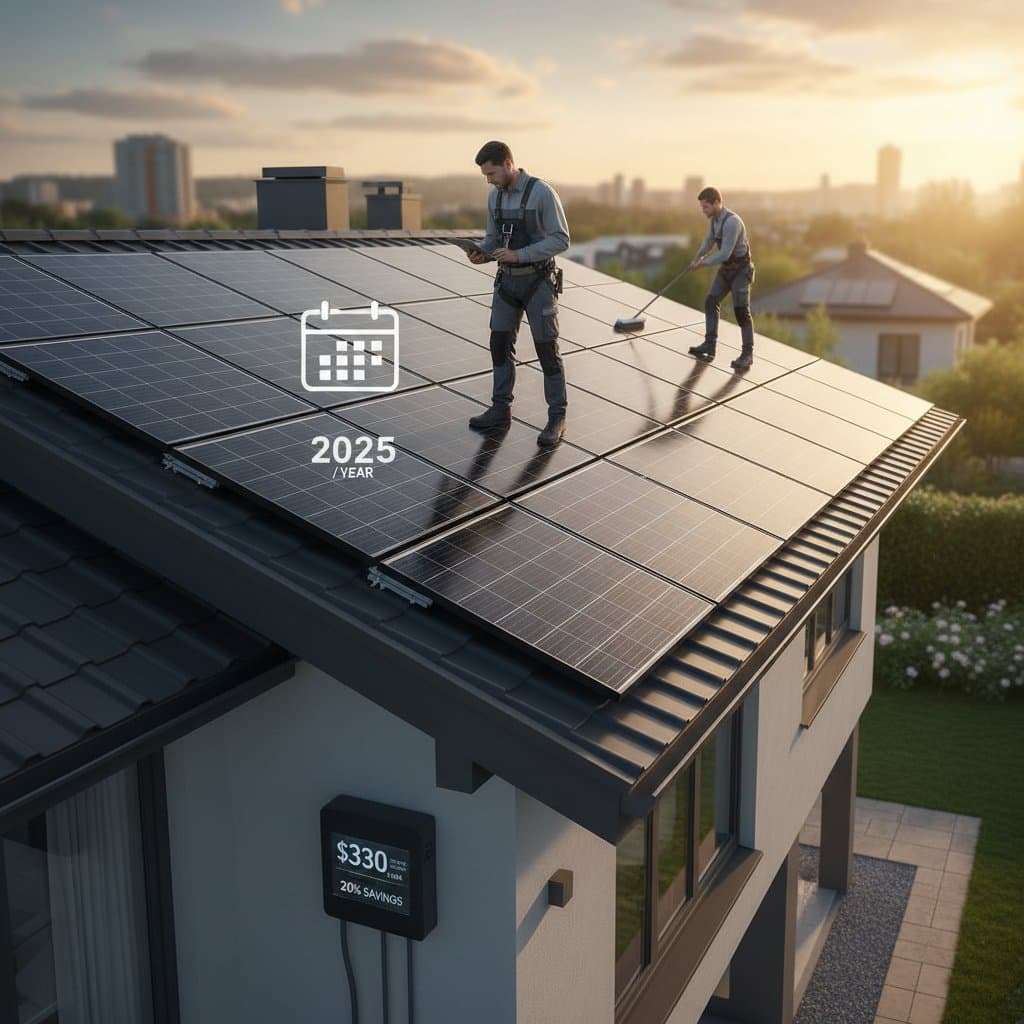Solar Panel Maintenance Costs 2025: ROI Timeline Revealed
Summary Box
National average cost: $330 per year
Typical range: $150 to $600 per year
Low end: $75 for basic cleaning on a small array
High end: $1,200 for full inspection, cleaning, and inverter service
Time to complete: 2 to 4 hours for a standard residential system
DIY or Pro: Cleaning can be DIY, inspections and electrical checks need a pro
ROI or resale impact: Regular maintenance protects 10 to 20 percent of expected energy savings and supports full resale value
Updated: March 2025
Cost Factors
Several elements influence the expense of solar panel maintenance. System size plays a primary role, as larger installations require more time and resources.
For instance, a 5 kW array typically takes under three hours to clean, whereas a 10 kW system may require double the effort and labor costs. Layout also matters; panels on complex roofs increase access challenges and associated fees.
Material grade and finish add another layer of consideration. High-efficiency panels with anti-reflective coatings demand specialized cleaning solutions to avoid scratches, leading certified technicians to charge premiums for careful handling and insurance coverage.
Roof pitch and access significantly affect pricing. Steep or multi-story installations necessitate additional safety equipment, which extends work time and raises rates. In contrast, ground-mounted systems often cost 25 to 40 percent less due to easier reach.
Local labor rates and seasonal demand vary costs further. Regions with high solar adoption or limited service providers see elevated prices. Spring and fall emerge as peak periods, particularly following pollen or dust accumulation that demands prompt attention.
Custom monitoring systems and warranty requirements can increase expenses. Certain warranties mandate annual professional inspections with documented proof; failure to comply risks voiding coverage, making these services essential for long-term protection.
Strategies to Reduce Costs Effectively
Adhering to a consistent maintenance schedule proves essential for cost control. Schedule cleanings once or twice annually, with additional rinses after major dust storms or pollen events. This approach prevents buildup that reduces energy output by 5 to 15 percent.
Bundling services offers substantial savings. Pair routine cleaning with yearly inspections through package deals from solar professionals, which can lower overall costs by 10 to 20 percent compared to individual appointments.
Preparation on the homeowner's part streamlines the process. Trim overhanging branches and clear roof gutters in advance to minimize on-site time, potentially reducing labor charges by a full hour.
Request itemized quotes to ensure transparency. Use this checklist when evaluating bids:
- Scope of work clearly itemized
- Panel count and access details noted
- Cleaning methods and solutions specified
- Inspection report format described
- Permit or disposal fees included
- Warranty terms outlined
- Payment schedule linked to milestones
Opt for off-season scheduling to capitalize on lower demand. Appointments in winter or early spring frequently come at reduced rates, as providers incentivize bookings during quieter periods.
Regular performance monitoring empowers proactive management. Review inverter output each month; a abrupt decline may indicate dirt accumulation or connection issues, allowing for timely interventions that avert larger repair expenses.
ROI Timeline and Payback Period
Effective maintenance safeguards energy production and equipment longevity. A standard residential solar system, priced at $12,000 to $18,000 after incentives, generates annual electricity savings of $800 to $1,200. Without upkeep, losses from dirt and shading can diminish these savings by $100 to $200 yearly, accumulating to an entire year's worth of performance over a decade.
The following table outlines a typical ROI progression for maintained systems:
| Stage | Years Since Install | Cumulative ROI | Notes |
|---|---|---|---|
| Early output | 1 to 3 | 10% to 20% | Light cleaning sustains high efficiency |
| Mid-life check | 4 to 7 | 40% to 60% | Inverter inspections and repair strategies |
| Peak performance | 8 to 12 | 70% to 90% | Consistent service upholds production levels |
| Long-term return | 13 to 20 | 100%+ | Full payback realized, with ongoing annual savings |
Systems receiving regular care achieve full payback in 8 to 12 years. Neglect extends this timeline by 2 to 4 years. An investment of $300 annually in maintenance secures over $1,000 in yearly savings, stabilizing the overall return.
Regional Maintenance Considerations
Climate-specific challenges require tailored approaches to maintenance. In desert and dry areas, dust and sand demand vigilant care.
Frequent rinsing every two months becomes necessary, which increases water use and accelerates seal wear. Implement automated monitoring to track accumulation efficiently.
Coastal environments expose systems to salt corrosion on frames and mounts. Select corrosion-resistant materials during installation and rinse panels with fresh water regularly to mitigate pitting and structural damage.
Cold or snowy regions benefit from natural snow shedding. Steep panel angles or heated surfaces encourage snow to slide off without intervention. Refrain from using hard tools for removal to prevent surface scratches.
Humid or forested areas face risks from moss, leaves, and moisture. Semi-annual cleanings address shading and trapped water, while inspections of roof flashing detect potential leaks early.
Essential Maintenance Practices and System Lifespan
Routine care forms the foundation of solar system durability. Clear debris from panels and examine visible wiring biannually for signs of discoloration, cracked glass, or sagging conduits.
Address common issues promptly to avoid escalation. Watch for inverter faults, loose roof mounts, corroded connectors, or output drops exceeding 10 percent from baseline performance.
Decisions between repair and replacement depend on efficiency thresholds. Panels seldom fail completely, but inverters and optimizers often require updates first. If output falls below 80 percent of rated capacity, consult a professional to weigh options.
Steps to Implement Maintenance Successfully
Begin by examining your installation warranty and prescribed schedule. Confirm required cleanings and inspections to preserve coverage validity.
Solicit quotes from at least three licensed solar specialists. Verify their insurance, client references, and sample reports to select a reliable partner.
This proactive routine not only minimizes costs but also maximizes the system's contributions to energy independence and financial returns over its 25-year lifespan.



